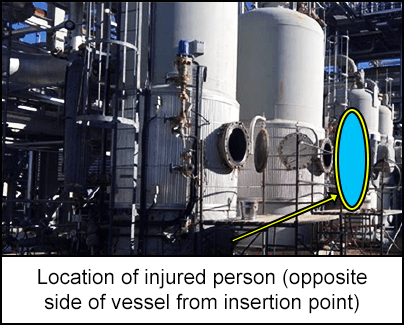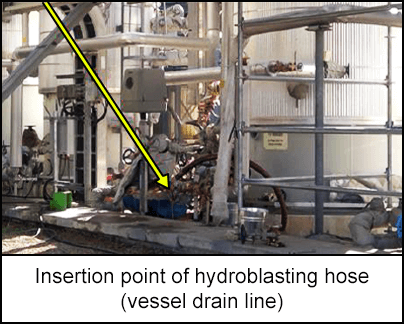-
What happened?
A work crew were preparing to clean scrubber drains using high pressure (HP) water blasting.
After the pre-job planning meeting, a valve was removed to access the drain line, scaffolding was assembled, and the manway cover was removed.
During the activity, one of the workers climbed onto the scaffolding on the opposite side of the vessel to complete a visual inspection.
The self-propelled nozzle of the hose came up the drain and towards the manway, placing the worker in the line of fire.
The worker was hit by high pressure water, receiving multiple lacerations on his body. This incident could have been fatal.

-
Why did it happen?
The work area was not barricaded as per the safety requirements. The manhole cover as a safety barrier.
The injured worker was unaware of the hazards (i.e. hose exiting the drain line and positioning him in the line of fire).

-
What did they learn?
Confirm that workers performing high pressure water blasting are competent and follow procedures.
Use checklists to ensure that all the key steps of a task are listed and followed.
Barricade work areas properly using all available barriers (e.g. manhole covers).
Ensure that job planning covers industry recommended safe work practice.

-
Ask yourself or your crew
What pre-job planning and checks do you do before a hydroblasting job?
What PPE do you wear for high pressure water blasting?
What measures do we have in place to prevent this from happening here? How can we improve?

Add to homescreen
Content name
Select existing category:
Content name
New collection
Edit collection
What happened?
A work crew were preparing to clean scrubber drains using high pressure (HP) water blasting.
After the pre-job planning meeting, a valve was removed to access the drain line, scaffolding was assembled, and the manway cover was removed.
During the activity, one of the workers climbed onto the scaffolding on the opposite side of the vessel to complete a visual inspection.
The self-propelled nozzle of the hose came up the drain and towards the manway, placing the worker in the line of fire.
The worker was hit by high pressure water, receiving multiple lacerations on his body. This incident could have been fatal.

Why did it happen?
The work area was not barricaded as per the safety requirements. The manhole cover as a safety barrier.
The injured worker was unaware of the hazards (i.e. hose exiting the drain line and positioning him in the line of fire).

What did they learn?
Confirm that workers performing high pressure water blasting are competent and follow procedures.
Use checklists to ensure that all the key steps of a task are listed and followed.
Barricade work areas properly using all available barriers (e.g. manhole covers).
Ensure that job planning covers industry recommended safe work practice.
Ask yourself or your crew
What pre-job planning and checks do you do before a hydroblasting job?
What PPE do you wear for high pressure water blasting?
What measures do we have in place to prevent this from happening here? How can we improve?
A work crew were cleaning the scrubber drain lines using high pressure water blasting, when the water struck another worker through an open manway.














